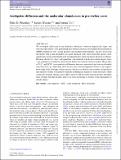Files in this item
Ambipolar diffusion and the molecular abundances in pre-stellar cores
Item metadata
| dc.contributor.author | Priestley, Felix D. | |
| dc.contributor.author | Wurster, James | |
| dc.contributor.author | Viti, Serena | |
| dc.date.accessioned | 2019-10-25T11:30:07Z | |
| dc.date.available | 2019-10-25T11:30:07Z | |
| dc.date.issued | 2019-09 | |
| dc.identifier | 262149971 | |
| dc.identifier | c58d89f9-a719-493d-8f5f-d02d8274b79e | |
| dc.identifier | 85074475939 | |
| dc.identifier.citation | Priestley , F D , Wurster , J & Viti , S 2019 , ' Ambipolar diffusion and the molecular abundances in pre-stellar cores ' , Monthly Notices of the Royal Astronomical Society , vol. 488 , no. 2 , pp. 2357-2364 . https://doi.org/10.1093/mnras/stz1869 | en |
| dc.identifier.issn | 0035-8711 | |
| dc.identifier.other | Bibtex: PriestleyWursterViti2019 | |
| dc.identifier.other | ORCID: /0000-0003-0688-5332/work/63716930 | |
| dc.identifier.uri | https://hdl.handle.net/10023/18771 | |
| dc.description.abstract | We investigate differences in the molecular abundances between magnetically super- and subcritical pre-stellar cores, performing three-dimensional non-ideal magnetohydrodynamical (MHD) simulations with varying densities and magnetic field strengths, and post-processing the results with a time-dependent gas–grain chemical code. Most molecular species show significantly more central depletion in subcritical models, due to the longer duration of collapse. However, the directly observable quantities – the molecule to hydrogen column density ratios – are generally too similar for observational data to discriminate between models. The profiles of N2H+ and HCO+ show qualitative differences between supercritical and subcritical models on scales of 0.01pc , which may allow the two cases to be distinguished. However, this requires knowledge of the hydrogen column density, which is not directly measureable, and predicted line intensity profiles from radiative transfer modelling are similar for these molecules. Other commonly observed species, such as HCN and CH3OH, have line intensity profiles that differ more strongly between models, and so are more promising as tracers of the mechanism of cloud collapse. | |
| dc.format.extent | 8 | |
| dc.format.extent | 807223 | |
| dc.language.iso | eng | |
| dc.relation.ispartof | Monthly Notices of the Royal Astronomical Society | en |
| dc.subject | Astrochemistry | en |
| dc.subject | MHD | en |
| dc.subject | Stars: formation | en |
| dc.subject | ISM: molecules | en |
| dc.subject | QB Astronomy | en |
| dc.subject | QC Physics | en |
| dc.subject | NDAS | en |
| dc.subject.lcc | QB | en |
| dc.subject.lcc | QC | en |
| dc.title | Ambipolar diffusion and the molecular abundances in pre-stellar cores | en |
| dc.type | Journal article | en |
| dc.contributor.institution | University of St Andrews. School of Physics and Astronomy | en |
| dc.identifier.doi | https://doi.org/10.1093/mnras/stz1869 | |
| dc.description.status | Peer reviewed | en |
| dc.identifier.url | http://orca.cf.ac.uk/id/eprint/124711 | en |
This item appears in the following Collection(s)
Items in the St Andrews Research Repository are protected by copyright, with all rights reserved, unless otherwise indicated.

